Wie Sie die Ballen Ihres Hundes pflegen
Tipps, um sie in gutem Zustand zu halten

WAS SIE NOCH NICHT ÜBER DIE BALLEN IHRES HUNDES WUSSTEN
Tiempo de lectura aproximada: 5 minutos
Die Ballen von Hunden schützen ihre Gliedmaßen vor äußeren Angriffen wie Schläge, Wunden oder sehr hohen oder sehr niedrigen Temperaturen. Auf eine gewisse Weise sind sie wie Schuhe für uns, aber dieses “Schuhwerk” ist ein Teil seines Organismus, und obwohl es ein sehr widerstandsfähiger Bereich ist, hat er viele Nervenenden, die ihn gleichzeitig sehr empfindlich machen.
Diese seltsamen Schutzvorrichtungen für die Pfoten Ihres Hundes sind nichts anderes als kleine Fettpolster, die für Elastizität sorgen, mit einer dünnen Keratinschicht, die für Widerstandsfähigkeit sorgt. Sie dienen dazu, den Aufprall von Tritten und mögliche Verletzungen von Knochen und Gelenken zu dämpfen. Wenn Welpen geboren werden, sind ihre Ballen ganz weich und matschig, aber mit der Zeit verhärtet sich die Haut und wird lederartig. Im Erwachsenenalter sind die Ballen dickhäutig und von dunkler Farbe. Dieser Bereich des Körpers Ihres Haustieres dient auch dazu, es vor Wunden und Verbrennungen zu schützen und seine Temperatur durch die dort befindlichen Schweißdrüsen zu regulieren. Dieser Schweiß wiederum trägt dazu bei, die Ballen mit Feuchtigkeit zu versorgen.
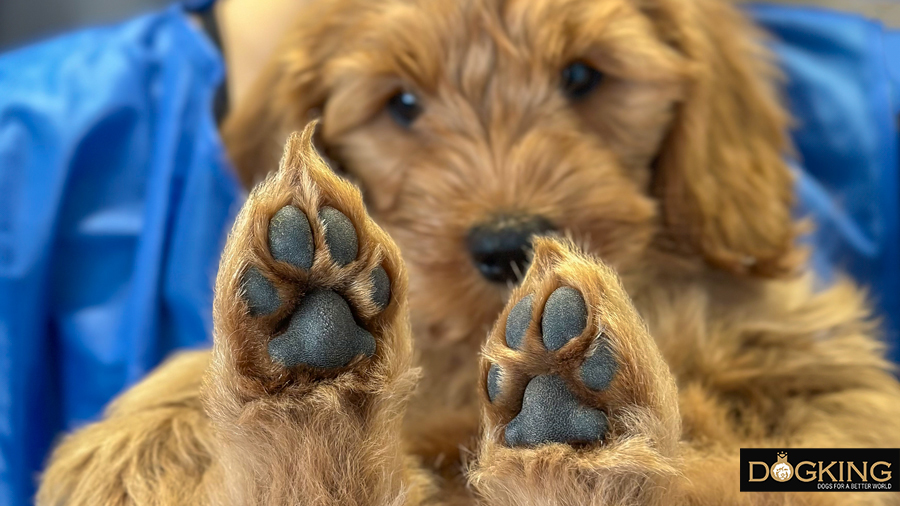
Inhaltsverzeichnis
1 - Probleme mit der Hundeunterlage und wie man sie vermeiden kann
2 - Tipps zur Erhaltung der Ballen Ihres Hundes in gutem Zustand
3 - Wie erkenne ich, ob mein Hund seine Ballen verletzt hat?
Probleme mit Hundeballen und wie man sie vermeiden kann
Es ist richtig, dass die Ballen von Hunden sehr widerstandsfähig sind, da sie immer in Kontakt mit dem Boden sind und sich mit der Zeit verhärten. Auch wenn wir die Analogie zu unseren Schuhen hergestellt haben, sind sie dennoch ein Teil ihres Körpers mit Nervenenden, die bei Schnitten, Wunden, Schlägen oder Verbrennungen starke Schmerzen verursachen. Daher ist es wichtig, dass Sie die wichtigsten Probleme kennen, die in den Ballen auftreten können, und wissen, wie Sie ihnen vorbeugen können und wie Sie sich verhalten müssen, wenn Ihr Hund ein Problem in diesem Bereich hat.
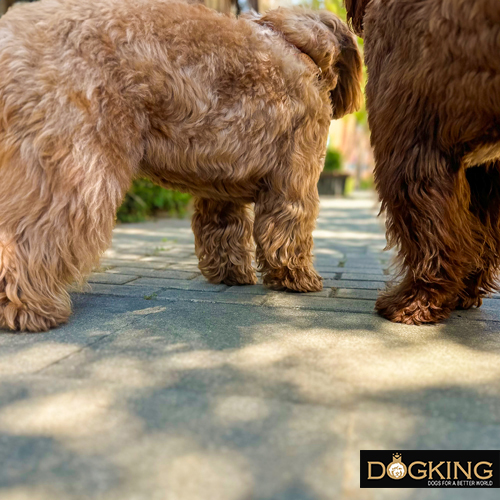
1. Verbrennungen
Wenn Sie mit Ihrem Hund einen Spaziergang machen, achten Sie auf die Bodentemperatur. Im Sommer kann der Asphalt bis zu 70 °C heiß werden, was zu Verbrennungen an den Pfotenballen Ihres Haustiers führen kann. Ebenso ist es nicht ratsam, dass die Haut der Pfoten Ihres Vierbeiners den Boden direkt berührt, wenn es sehr, sehr kalt ist, z. B. wenn Schnee liegt, denn auch hier kann es zu Reizungen und Abschürfungen kommen. Vermeiden Sie in diesen Fällen am besten Zeiten, in denen die Temperatur zu hoch oder zu niedrig ist, und prüfen Sie immer den Zustand des Bodens, indem Sie ihn mit dem Handrücken berühren. Wenn Sie es nicht 5 Sekunden aushalten können, ohne sich zu verbrennen, kann das auch ihr Hund nicht. Im Winter können Sie speziellen Schutz benutzen, wenn Sie in einem sehr kalten Klima leben. Verbrennungen bei Bodentemperaturen werden mit speziellen Salben behandelt. Wenn die Verletzung Ihres Hundes also schwerwiegend ist, sollten Sie sich an Ihren Tierarzt wenden, um die beste Behandlung zu erhalten.
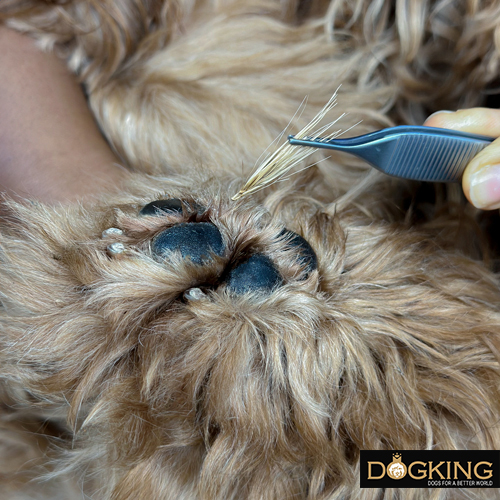
2. Festgenagelte Gegenstände
Stellen Sie sich vor, Sie gehen den ganzen Tag barfuß. Egal wie robust und widerstandsfähig die Haut an Ihren Füssen ist, es kann passieren, dass Sie sich mit tausend Dingen darin verfangen Hunde, die ständig mit dem Boden in Berührung kommen, können sich an Gegenständen, die ihnen in den Weg kommen, kleine Schnitte und Wunden zuziehen, und es kann sogar vorkommen dass Glas, Steine oder Stachen die Haut ihrer Pfoten durchbohren. Dieses Problem lässt sich bis zu einem gewissen Grad nicht vermeiden, obwohl wir immer darauf achten können, wo wir mit unserem Haustier spazieren gehen. Versuchen Sie, Bereiche mit Stacheln zu vermeiden, denn die pfeilförmigen Stacheln graben sich in die Haut des Tieres und verursachen viele Probleme mit Entzündungen und sogar Abszessen, wenn sie nicht entfernt werden. Wir empfehlen auch, den Boden zu beobachten, um Ihren Hund an der Leine zu führen, falls Sie an einer Stelle mit kleinen Kieselsteinen, Glas oder anderen gefährlichen Gegenständen vorbeikommen.
Wenn Ihr Hund etwas in seinen Ballen stecken hat und Sie nicht sicher sind, ob Sie es zu Hause entfernen können, gehen Sie zum Tierarzt, um ihn sicher entfernen zu lassen. In leichteren Fällen können Sie dies selbst tun, indem Sie die Stelle mit Chlorhexidin desinfizieren und den Fremdkörper vorsichtig entfernen.
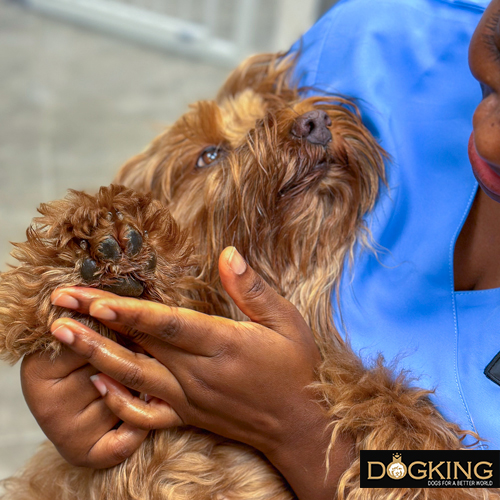
3. Dehydrierung
Wenn Sie nicht richtig die Ballen Ihres Hundes mit Feuchtigkeit versorgen, werden Sie wahrscheinlich feststellen, dass der Bereich anfängt, rissig zu werden. Die Feuchtigkeit an dieser Stelle aufrechtzuerhalten ist wichtig und Sie können dies durch Vaseline oder spezielle Produkte für diesen Zweck verwenden, die oft feuchtigkeitsspendende Inhaltsstoffe wie Aloe Vera enthalten. Achten Sie natürlich darauf, dass Ihr Hund ausreichend Wasser trinkt, vor allem im Sommer. Wenn das Problem weiterhin besteht, sollten Sie Ihren Tierarzt aufsuchen, um andere Probleme auszuschließen.
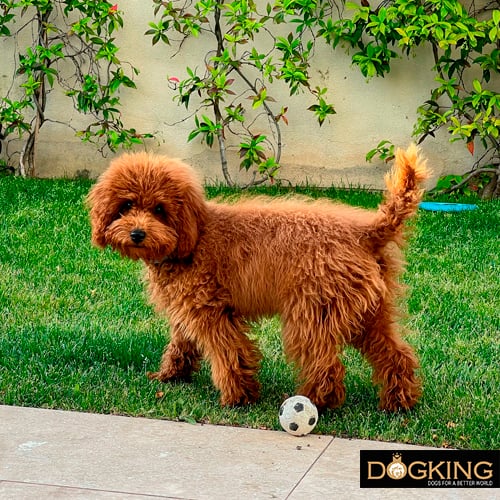
4. Erosión
Erosions-oder Scheuerprobleme an den Ballen von Hunden sind häufig auf übermäßige Bewegung oder harte Oberflächen zurückzuführen. Wenn Ihr Haustier ein Problem hat mit dem Belag an seinen Pfoten, sollten Sie überlegen, auf welchem Boden Sie laufen, und versuchen, ihn mit weicheren Oberflächen, wie z.B. Gras, zu kombinieren. Hinzu kommt auch noch, dass Sie nicht vergessen sollten, dass Bewegung zwar sehr gesund für Ihren pelzigen Freund ist, aber in Maßen erfolgen sollte, da zu viel Laufen die Haut an den Ballen erodieren kann. Paradoxerweise kann auch eine unzureichende körperliche Betätigung zu Scheuerstellen und Wunden führen, da die Haut dünner und brüchiger wird und anfälliger für Verletzungen ist. Für diese Fälle gibt es spezielle Cremes, die diesen Bereich des Hundekörpers abhärten, aber es ist besser, es nicht dazu kommen zu lassen und ihm ein aktives und ausgeglichenes Leben zu bieten.
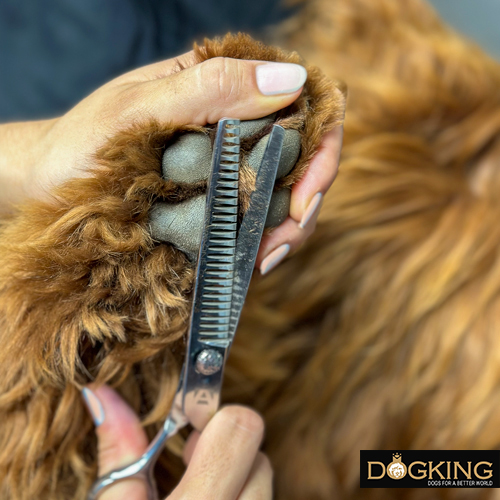
5. Verformung
Im Gegensatz zu Verbrennungen und Einstichwunden ist dies kein so häufiges Problem, aber es kann Ihrem Hund passieren, wenn er dazu neigt, zwischen den Zehen viele Haare wachsen zu lassen. In diesem Fall ist es besser, wenn Sie es regelmäßig schneiden, um Knoten zu vermeiden. Gewöhnen Sie Ihren Hund schon im Welpenalter an den Umgang mit seinem Körper, einschließlich seiner Pfoten. Dies ist eine große Hilfe bei der Untersuchung seiner Ballen, der Entfernung überschüssiger Haare und dem Trimmen seiner Nägel. Ein weiterer Grund, warum sich die Ballen Ihres Hundes verformen können, sind zu lange Nägel, die ihn am normalen Laufen hindern und die Physiognomie dieses Körperteils beeinträchtigen. Wenn Sie nicht wissen, wie man die Nägel Ihres Haustieres schneidet, gehen Sie zu einem spezialisierten Zentrum, um Probleme zu vermeiden.
Ratschläge zur Erhaltung der Ballen Ihres Hundes in gutem Zustand
Wenn Sie diesen robusten, aber empfindlichen Körperteil Ihres Hundes gesund erhalten wollen, sollten Sie sich angewöhnen, ihn regelmäßig zu kontrollieren. Schauen Sie sich die Ballen Ihres Hundes jeden Tag, wenn Sie von einem Spaziergang zurückkommen, genau an, um festzustellen, ob Gegenstände darin stecken. Sie können die Ballen bei dieser Gelegenheit auch mit einem feuchten Tuch reinigen, denn eine gute Hygiene in diesem Bereich ist ebenfalls sehr wichtig, um Probleme zu vermeiden. Trocknen Sie die Ballen anschließend gut mit einem Trockentuch ab, und belohnen Sie Ihren Hund, wenn er die Inspektion gut überstanden hat, mit einem Leckerli, Kuscheln oder einer schönen Spielstunde. Befeuchten Sie die Ballen regelmäßig, damit sie nicht austrocknen.
Eine andere Sache, die Sie bedenken sollten, ist, dass die Ballen Ihres Hundes bei Nässe weicher und die Haut empfindlicher wird. Im Sommer, wenn Sie an den Strand gehen, mit Ihrem Hund an den Hundestrand gehen oder im Schwimmbad schwimmen, achten Sie auf den nassen Boden. Trocknen Sie so schnell wie möglich, damit Sie sich nicht verletzen. Wenn Sie es einrichten können, ist es viel besser, nach dem Bad einen Spaziergang zu machen,egal ob es sich um ein Freizeitbad oder ein Bad zu Hause handelt, das der Hygiene dient.
Wie erkenne ich, ob mein Hund seine Ballen verletzt hat?
Wenn Ihr Hund Beschwerden an den Pfoten verspürt, weil er entweder Verbrennungen hat, geschlagen oder genagelt wurde, kann es sein, dass er humpelt, die Stelle häufig ableckt oder nicht aufsteht. Wenn Sie diese Anzeichen bemerken, sollten Sie die Ballen Ihres Hundes untersuchen, aber seien Sie behutsam, da er bei Berührung Schmerzen empfinden kann. Wenn Sie bemerken, dass tatsächlich etwas mit einem der Ballen Ihres Tieres nicht in Ordnung ist und Sie das Problem nicht zu Hause beheben können, bringen Sie ihn zum Tierarzt und verwenden Sie in der Zwischenzeit Socken oder Pads, damit Ihr Hund weiterhin spazieren gehen kann (sofern es sich nicht um eine sehr schwere Verletzung handelt).
Wenn Sie die Ballen Ihres Haustieres stärken wollen, empfehlen wir, seine Pfoten von klein auf verschiedenen Untergründen auszusetzen, zunächst mit kurzen Spaziergängen, die dann immer länger werden. Dann hat er geländegängige Ballen und ist nicht so anfällig für Verletzungen und Stöße.